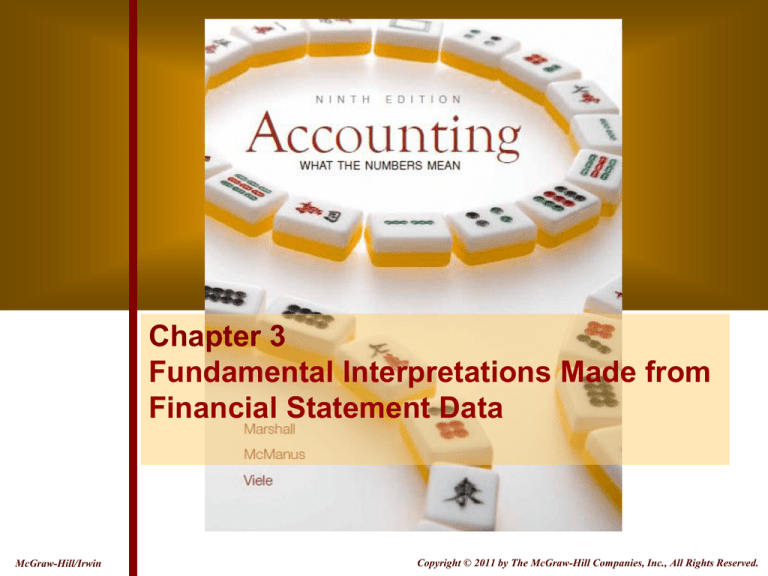
1-1
3-1
© 2008 The McGraw-Hill Companies, Inc., All Rights Reserved.
Chapter 3
Fundamental Interpretations Made from
Financial Statement Data
McGraw-Hill/Irwin
McGraw-Hill/Irwin
3-1
Copyright
2011 by The McGraw-Hill
Companies,
Inc.,Rights
All Rights
Reserved.
© 2008
The©McGraw-Hill
Companies,
Inc., All
Reserved.
Chapter 3
1-2
3-2
Fundamental Interpretations Made from
Financial Statement Data
LEARNING OBJECTIVES
To understand:
1. Why financial statement ratios are important.
2. The importance and calculation of return on investment.
3. How to calculate and interpret margin and turnover using the DuPont model.
4. The significance and calculation of return on equity.
5. The meaning of liquidity and why it is important.
6. The significance and calculation of working capital, the current ratio, and the acid-test
ratio.
7. How trend analysis can be used most effectively.
McGraw-Hill/Irwin
3-2
© 2008 The McGraw-Hill Companies, Inc., All Rights Reserved.
1-3
3-3
LO1
Financial Ratios and Trend
Analysis
A ratio is simply the
relationship between
two numbers.
McGraw-Hill/Irwin
The large dollar amounts
reported on the financial
statements of many
companies, and the
varying size of
companies, make ratio
analysis the only sensible
method of evaluating
various financial
characteristics.
3-3
© 2008 The McGraw-Hill Companies, Inc., All Rights Reserved.
1-4
3-4
LO1
Trend Analysis
Trend analysis
compares a single
observation over
several years.
McGraw-Hill/Irwin
3-4
© 2008 The McGraw-Hill Companies, Inc., All Rights Reserved.
1-5
3-5
LO2
Rate of Return
Rate of
=
return
Amount of return
Amount of investment
This ratio provides the return on a given
investment alternative. All other things
being equal, the higher the rate of return,
the more profitable the alternative.
The rate of return calculation is derived
from the interest calculation.
Interest = Principal × Rate × Time
Higher rates of return are associated with
greater risk!
McGraw-Hill/Irwin
3-5
© 2008 The McGraw-Hill Companies, Inc., All Rights Reserved.
1-6
3-6
LO2
Return on Investment (R.O.I.)
Return on
=
investment
Net income
Average total assets
This ratio describes the rate of return
management was able to earn on the assets
that it had available during the year.
An informed judgment about the firm’s
profitability requires relating net income to
the assets used to generate that net income.
McGraw-Hill/Irwin
3-6
© 2008 The McGraw-Hill Companies, Inc., All Rights Reserved.
1-7
3-7
The DuPont Model
LO3
Return on
Net income
=
investment
Sales
Margin
×
Sales
Average total assets
Turnover
The DuPont model is an expansion of the
basic ROI calculation.
The developers of the model reasoned
that profitability from sales and utilization
of assets to generate sales revenue were
both important factors to be considered
when evaluating profitability.
McGraw-Hill/Irwin
3-7
© 2008 The McGraw-Hill Companies, Inc., All Rights Reserved.
1-8
3-8
The DuPont Model
LO3
Return on
Net income
=
investment
Sales
McGraw-Hill/Irwin
×
Sales
Average total assets
Margin
Turnover
Emphasizes that
from every dollar
of sales revenue,
some amount
must work its
way to net
income.
Relates
efficiency with
which the firm’s
assets are used
in the revenuegenerating
process.
3-8
© 2008 The McGraw-Hill Companies, Inc., All Rights Reserved.
1-9
3-9
The DuPont Model
LO3
Return on
Net income
=
investment
Sales
Margin
×
Sales
Average total assets
Turnover
A rule of thumb useful for putting ROI
in perspective is that average ROI,
based on net income, for most
American merchandising and
manufacturing companies is between
8% and 12%.
McGraw-Hill/Irwin
3-9
© 2008 The McGraw-Hill Companies, Inc., All Rights Reserved.
1-10
3-10
LO4
Return on Equity (ROE)
Return on
=
equity
Net income
Average owners’ equity
Owners are interested in expressing the
profits of the firm as a rate of return on the
amount of owners’ equity.
As a rule of thumb, average ROE for most
American merchandising and
manufacturing companies has historically
ranged from 10% to 15%.
McGraw-Hill/Irwin
3-10
© 2008 The McGraw-Hill Companies, Inc., All Rights Reserved.
1-11
3-11
LO5
Working Capital
Current assets
- Current liabilities
Working capital
Working capital is the excess of a firm’s
current assets over its current liabilities.
McGraw-Hill/Irwin
3-11
© 2008 The McGraw-Hill Companies, Inc., All Rights Reserved.
1-12
3-12
LO6
Current Ratio
Current
ratio
=
Current assets
Current liabilities
This ratio measures the ability
of the company to pay current
debts as they become due.
As a rule of thumb, a current
ratio of 2.0 is considered
indicative of adequate liquidity.
McGraw-Hill/Irwin
3-12
© 2008 The McGraw-Hill Companies, Inc., All Rights Reserved.
1-13
3-13
LO6
Acid-Test Ratio
The acid-test ratio is also known as the quick ratio.
Acid-test
=
ratio
Quick assets
Current liabilities
Quick assets are cash (including
temporary cash investments) and
accounts receivable.
This ratio provides information about an almost worst-case
situation—the firm’s ability to meet its current obligations
even if none of the inventory can be sold.
As a rule of thumb, an acid-test ratio of 1.0 is considered
indicative of adequate liquidity.
McGraw-Hill/Irwin
3-13
© 2008 The McGraw-Hill Companies, Inc., All Rights Reserved.
1-14
3-14
LO7
Trend Analysis
Intel Corporation
Income Information
For the Years Ended December 31
Item
Return on investment
Return on equity
Working capital
Year
2008
2007
2006
10.80%
13.40%
10.40%
12.90%
17.50%
13.80%
$ 12,053 $ 15,314 $ 9,766 $
2005
18.00%
23.20%
11,960 $
2004
15.80%
19.70%
16,052
Source: Intel Corporation, 2008 Annual Report, pp.26, 56-57.
This table illustrates the trend analysis of
return on investment, return on equity and
working capital.
McGraw-Hill/Irwin
3-14
© 2008 The McGraw-Hill Companies, Inc., All Rights Reserved.
1-15
3-15
Trend Analysis
LO7
We can use the
trend analysis to
construct graphs
so we can see
trends over time.
Return (%)
25.00%
20.00%
Return on
Investment
15.00%
10.00%
Return on Equity
5.00%
0.00%
2004
2005
2006
2007
2008
Year
Working Capital ($)
Source: Intel Corporation, 2008 Annual Report, pp.26, 56-57.
$20,000
$15,000
$10,000
$5,000
$0
2004
2005
2006
2007
2008
Year
McGraw-Hill/Irwin
3-15
© 2008 The McGraw-Hill Companies, Inc., All Rights Reserved.




